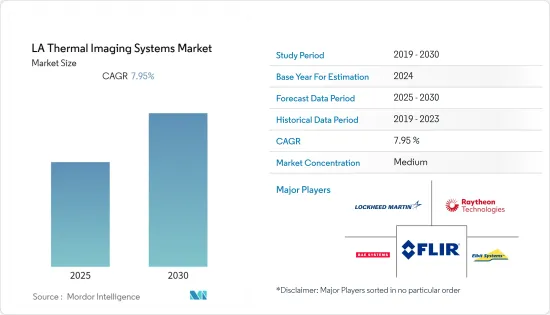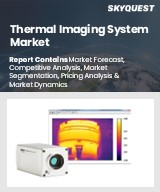
|
시장보고서
상품코드
1637842
라틴아메리카의 열화상 시스템 시장 - 점유율 분석, 산업 동향, 성장 예측(2025-2030년)LA Thermal Imaging Systems - Market Share Analysis, Industry Trends & Statistics, Growth Forecasts (2025 - 2030) |
||||||
라틴아메리카의 열화상 시스템 시장은 예측 기간 동안 CAGR 7.95%를 기록할 전망입니다.

주요 하이라이트
- 많은 기업들이 기술의 진보에 의해 IR/열화상 시스템 센서를 소형화해, 높은 효율성을 실현함으로써 사용의 용이성을 향상시키고 있습니다. 핸드헬드 IR/열화상 시스템은 휴대성으로부터 지지를 모아 병원 등 다양한 기업에서 응용되어 수리 시간과 난방 비용을 절약하고 있습니다.
- 예를 들어 디지털 상처 치료 기술의 세계 기업인 Swift Medical은 지난해 3월 스마트폰 카메라에 무선으로 설치하여 상세한 임상 데이터를 획득하여 피부와 상처의 상태 평가, 치료, 모니터링을 지원하는 획기적인 하드웨어 장비, Swift Ray 1을 발표했습니다. Swift Ray 1은 임상의와 환자의 손에 들어갈 정도로 작고 병원에서 환자 집까지 어디서나 강력한 의료 이미지를 얻을 수 있습니다. 이 첨단 이미지 덕분에 피부색에 관계없이 모든 환자의 정확한 임상 데이터를 수집 할 수 있으며 모든 사람에게 상처 케어가 더 공급됩니다.
- 또한, 열화상 시스템은 임상용 열화상 시스템으로 암, 감염, 외상, 혈관 질환의 조기 발견에 이용되고 있습니다. 열화상 시스템은 인체가 방사하는 열량에 따라 화상을 생성하기 때문에 가장 우수한 예방검진의 하나가 되고 있습니다. 따라서 의료용으로 열화상시스템의 이용이 확대되면 열화상시스템 시장이 성장할 가능성이 높습니다.
- 이 지역의 국가들은 여러 가지 이유로 군사 투자를 적극적으로 수행하고 있습니다. 많은 라틴아메리카 국가들은 국경 관리, 해적 대책, 조직 범죄 및 마약 카르텔 대책 등 군사 예산을 확대하고 있습니다. 적외선 열 카메라는 육상·해상을 불문하고 국경 부근의 섬세한 징후를 추적하는 등 다양한 방법으로 군사를 지원하고 있습니다.
- 또한 SIPRI에 따르면 멕시코 군사비는 지난해 80억 4,490만 달러에 비해 최근 86억 8,080만 달러로 증가했습니다. 멕시코는 로페즈 오브라도르 대통령 하에 국가 경비대를 군의 관리하에 둔다는 계획을 내세워 국립공원부터 국내의 반범죄 활동까지 시민 활동의 군사화를 확대하는 것을 목표로 하고 있습니다. 이러한 활동은 이 지역에서 적외선 열 카메라 수요를 더욱 높일 수 있습니다.
- 이 시장에서 많은 기업들이 지속적으로 혁신적인 제품을 개발하고 있습니다. 예를 들어, FLIR Systems는 작년 11월 적외선 열 카메라의 신제품인 FLIR One Edge Pro를 발표했습니다. 이 제품은 기존 FLIR One Edge의 업그레이드 버전으로 출시되었습니다. 스마트폰의 후면 패널에 쉽게 설치할 수 있기 때문에 스마트폰에 렌즈를 연결하여 출력을 얻을 필요가 없습니다. 또한 가시 카메라의 이미지 데이터를 겹쳐서 열화상 시스템을 보기 쉽게 하는 MSX 모드도 탑재되어 있습니다. 또한 소프트웨어의 강화도 이루어지고 있습니다.
- FDA는 공중보건 긴급시 열화상 시스템의 가용성을 확대하고 체온계 부족을 완화하기 위해 “코로나바이러스 감염 2019(COVID-19) 공중보건 긴급시 텔레열화상 시스템 시행 방침 '가이던스를 발표했습니다. 이 지침은 COVID-19와 관련된 공중 보건 응급 상황에서 의료 목적으로 설계된 모든 적외선 이미징 시스템에 적용되도록 의도된 시행 정책을 수립합니다.
라틴아메리카 열 화상 시스템 시장 동향
자동차 용도가 시장 성장을 견인
- 운전자 없이 자율 주행하는 첨단 자동차에 대한 수요로 소비자에게 프리미엄 경험을 제공하는 데 도움이 되는 적외선 이미징 기술의 요구가 확대되고 있습니다. 차량 시스템을 감지하고 사용하기 위해 여러 센서가 사용됩니다. 열 카메라는 전체 차량의 기능을 지원하는 근접 센서와 함께 작동합니다.
- 게다가 작년 11월, 산 안드레스 대학의 AI 로봇 공학 연구소는 아르헨티나 도로를 달리는 최초의 무인 운전차의 인가 취득을 목표로 내걸었습니다. 첫 번째 테스트는 푼타치카 캠퍼스에서 실시되었으며, 대학은 R&D에 25만 달러를 투자했습니다.
- 적외선 열 카메라는 가혹한 조명과 날씨에서도 운전자의 시야를 확보하고 사고를 피하고 안전을 보장하기 위해 자동차 산업에서 사용됩니다. 자동차 제조업체와 적외선 이미지 솔루션 공급업체는 협력하여 자동차 산업을 위한 혁신적인 적외선 솔루션을 개발하고 있습니다. INEGI에 따르면 지난해 멕시코 승용차 생산 대수는 348만 대로 전년 297.9만 대를 웃돌았습니다.
- 자동차 산업에서는 ADAS(첨단 운전 지원 시스템)라고 불리는 하이테크 자율주행차의 보급이 진행되고 있습니다. 서멀 카메라, 전파 감지·측정 센서, 광 감지·측정 센서, 근접 센서 등 다수의 센서가, 자동 운전, 네비게이션, 보다 좋은 상황 인식을 가능하게 하기 위해, 이러한 자동차로 운전자를 대신합니다. 이러한 자동차에 대한 수요 증가는 시장 성장을 더욱 촉진할 수 있습니다.
- 예를 들어, Owl Autonomous Imaging은 작년 1월 CES 2023에서 회사의 Thermal Ranger ADAS & Autonomous Navigation Development Platform 평가 키트를 발표했습니다. 이 하드웨어 및 소프트웨어 키트를 통해 Tier-1 및 OEM 자동차 회사는 L2, L2, L3/L4 에센셜을 지원하는 PAEB 및 기타 ADAS 기능에 사용되는 Owl AI의 열 레인저 이미징 솔루션을 쉽게 평가할 수 있습니다. 이 회사의 열 카메라 솔루션은 물체 분류, 물체의 3D 세분화, RGB-열 융합, 고정밀 거리 측정을 위한 2D 및 3D 지각을 가능하게 합니다.
큰 시장 점유율을 차지하는 브라질
- 브라질은 군 및 방위, 석유 및 가스, 자동차 등 다양한 부문에 대한 지출 증가로 적외선 열 카메라 시장 규모가 크게 확대되고 있습니다. 또한 Global Firepower에 따르면 브라질의 국방예산은 전년도 시점에서 라틴아메리카에서 가장 많아 총액 약 187억 9,000만 달러에 이릅니다.
- 브라질의 군 및 방위 산업은 적외선 열 카메라를 재빨리 도입하고 있습니다. 국방부가 모니터링에 대한 투자를 늘리면서 적외선 열 카메라의 사용이 확대될 것으로 예측됩니다. 예를 들어, 브라질 육군은 지난해 3월 정보·모니터링·목표 포착·정찰(ISTAR) 임무용으로 주문한 Nauru 1,000C 무인 항공기(UAV)의 수령을 시작했습니다. Nauru 1,000C는 고정날개 수직이착륙(VTOL) 무인기로 전천후형 주간 및 야간 대응 멀티미션으로 운용할 수 있습니다. 이러한 계약은 예측 기간 동안 동 부문의 성장 전망을 촉진할 것으로 예상됩니다.
- 라틴아메리카 전역의 정부는 군사 부대에게 더 나은 정확한 정보를 제공함으로써 차세대 기술에 투자하고 있습니다. 군사 산업에서 적외선 열화상 시스템 장비의 사용은 증가하고 있으며, 적외선 카메라, 특히 단파장 적외선 카메라의 상승에 영향을 미치고 있습니다.
- 이 지역에서는 범죄와 폭력 증가 추세도 두드러집니다. 그 결과, 국토 안보부대의 예산이 증가하고, 첨단 보호 시스템이나 장치를 구입하게 되었습니다. 현대의 전투는 수많은 비치명적, 살상적 무기에 의해 점점 비대칭성이 증가하고 있습니다. 예를 들어 지난해 8월 미국 국방안보협력국(DSCA)은 브라질에 대한 자벨린 미사일과 관련 장비의 대외군사 매각(FMS)을 의회에 통고했습니다. 이 매각의 일환으로 브라질 정부는 최대 33대의 자베린 발사 유닛(CLU)과 222기의 FGM-148 자베린 대전차 미사일의 구매를 요청했습니다. 계약 금액은 약 7,400만 달러입니다. 이와 같이 군사력 강화를 위한 첨단 무기 시스템과 C4ISR 시스템의 조달이 증가하고 있는 것이 전국 시장 성장의 원동력이 되고 있습니다.
라틴아메리카 열화상 시스템 산업 개요
라틴아메리카의 열화상 시스템 시장은 부분적으로 분할되어 있으며 여러 대형 기업으로 구성되어 있습니다. 그 중에는 Axis Communications, FLIR, Fluke Corporation, Bae Systems, Elbit Systems Ltd, Raytheon Co., Lockheed Martin 등이 있습니다. 그러나 많은 기업들이 새로운 계약을 획득하고 새로운 시장을 개척함으로써 혁신적인 솔루션으로 시장에서의 존재감을 높이고 있습니다.
- 2022년 12월 - Teledyne Technologies Incorporated 산하 Teledyne FLIR은 세계 최초의 완전 핸즈프리, 음성 제어의 열 카메라 모듈을 최근 발표하고, 어시스트 리얼리티 웨어러블 솔루션의 선구자인 RealWear를 최신 Thermal by FLIR 협력 기업으로 맞이했습니다. Thermal by FLIR과 제휴하는 Ulefone은 최근 Lepton 3.5 열 카메라 모듈이 장착된 5GAndroid 휴대전화 Power Armor 18T를 출시했습니다.
- 2022년 1월 - Xenics는 고성능, 고해상도의 새로운 열화상 시스템 장파장 적외선(LWIR) 카메라, Ceres T 1280을 발매. Xenics는 Ceres T 1280에서 고성능 열화상 시스템 카메라 라인업을 확장했습니다.
기타 혜택
- 엑셀 형식 시장 예측(ME) 시트
- 3개월의 애널리스트 서포트
목차
제1장 서론
- 조사의 전제조건과 시장 정의
- 조사 범위
제2장 조사 방법
제3장 주요 요약
제4장 시장 인사이트
- 시장 개요
- 밸류체인/서플라이체인 분석
- 산업의 매력 - Porter's Five Forces 분석
- 신규 참가업체의 위협
- 구매자의 협상력
- 공급기업의 협상력
- 대체품의 위협
- 경쟁 기업간 경쟁 관계의 강도
- COVID-19의 산업에 대한 영향 평가
제5장 시장 역학
- 시장 성장 촉진요인
- 다양한 용도로 사용되는 열화상 시스템
- 열화상 시스템의 기술 향상
- 시장 성장 억제요인
- 정기적인 지원과 서비스의 부족
제6장 시장 세분화
- 솔루션별
- 하드웨어
- 소프트웨어
- 서비스
- 제품 유형별
- 고정형 열화상 시스템
- 핸드헬드 열화상 시스템
- 용도별
- 보안 및 모니터링
- 모니터링·검사
- 검지·계측
- 최종 사용자별
- 항공우주 및 방위
- 자동차
- 의료 생명과학
- 석유 및 가스
- 음식
- 기타
- 국가별
- 브라질
- 아르헨티나
- 기타 라틴아메리카
제7장 경쟁 구도
- 기업 프로파일
- Flir Systems Inc.
- BAE Systems PLC
- Elbit Systems Ltd
- Raytheon Company
- Lockheed Martin Corporation
- L-3 Communications Holdings
- Fluke Corporation
- Axis Communications
- Leonardo SpA
제8장 투자 분석
제9장 시장의 미래
JHS 25.02.06The LA Thermal Imaging Systems Market is expected to register a CAGR of 7.95% during the forecast period.

Key Highlights
- Most companies have miniaturized IR and thermal imaging sensors due to technological advancements, making them highly efficient, thereby raising their ease of use. Handheld IR and thermal imaging systems gain traction for their portability and find applications in various enterprise verticals, such as hospitals, saving repair times and heating costs.
- For instance, in March last year, Swift Medical, the global player in digital wound care technology, unveiled the Swift Ray 1, a game-changing hardware device that wirelessly attaches to a smartphone camera and captures detailed clinical data to aid in the assessment, treatment, and monitoring of skin and wound conditions. The Swift Ray 1 is small enough to fit in a clinician's or patient's hand, making powerful medical imaging obtainable anywhere, from the hospital to the patient's home. Because of this advanced imaging, accurate clinical data can be collected for every patient, regardless of skin tone, making wound care more equitable for all.
- In addition, thermal cameras are used in clinical thermography to identify cancer, infections, traumas, and vascular disease at an early stage. Thermal cameras create pictures depending on how much heat the human body radiates, making it one of the greatest preventative health screening approaches. As a result, the thermal imaging market will likely grow as prospects for thermal imaging in healthcare applications expand.
- The countries in the region are aggressively investing in their military for various reasons. Many Latin American countries are expanding their military budgets, including border management, anti-piracy procedures, and combatting organized crime and drug cartels. Thermal imaging aids armies in different ways, including tracing minor signs near borders, whether on land or sea.
- In addition, according to the SIPRI, military expenditure in Mexico increased to USD 8680.80 million recently compared previous year's recorded USD 8044.90 million. Mexico aims to increase the militarization of civilian activities, ranging from national parks to domestic anti-crime operations, with a plan under the premiership of President Lopez Obrador to bring the country's National Guard under military control. Such activities may further create demand for thermal imaging systems in the region.
- Many players in the market are continuously developing innovative products that may drive market demand. For instance, in November last year, FLIR announced its new thermal camera, FLIR One Edge Pro. It has been launched as an upgrade to the existing FLIR One Edge. It can easily be attached to the smartphone's rear panel, eliminating the need to connect the lens to a smartphone to get output. It also includes an MSX mode, which overlays image data from the visible camera to make thermal images simpler to read. There have also been some software enhancements.
- The FDA published the Enforcement Policy for Telethermographic Systems During the Coronavirus Disease 2019 (COVID-19) Public Health Emergency guidance to help expand the availability of thermal imaging systems and mitigate thermometer shortages during the public health emergency. The guidance sets forth an enforcement policy intended to apply to all thermal imaging systems designed for medical purposes during the public health emergency related to COVID-19.
Latin America Thermal Imaging Systems Market Trends
Automotive in Applications to Drive the Market's Growth
- The demand for advanced vehicles, which are driverless and autonomous, has expanded the need for thermal imaging techniques that help deliver a premium experience to the consumer. Multiple sensors are used to detect and utilize the vehicle's system. Thermal cameras are operated along with proximity sensors that help the entire vehicle's function.
- In addition, in November last year, the AI and Robotics Laboratory of the University of San Andres set the goal of obtaining authorization for the first driverless vehicle that circulates on Argentine roads. The first tests were carried out on the Punta Chica campus, and the university invested USD 250,000 in R&D.
- Thermal imaging cameras are used in the automobile industry to allow drivers to see in harsh lighting and weather situations to avoid accidents and assure safety. Automotive manufacturers and thermal imaging solution suppliers are working together to develop innovative thermal solutions for the automotive industry. According to INEGI, last year, the total production of passenger vehicles in Mexico was recorded at 3,480 (in thousands) from the previous year, which was registered at 2,979.
- The automobile industry is gaining traction with high-tech autonomous cars, also known as advanced driver-assistance systems. Multiple sensors, including thermal cameras, radio detection and ranging, light detection and ranging sensors, and proximity sensors, substitute drivers in these cars to enable automated driving, navigation, and better situational awareness. Increasing demand for these cars may further drive the market's growth.
- For instance, in January last year, Owl Autonomous Imaging announced Evaluation Kit for its Thermal Ranger ADAS & Autonomous Navigation Development Platform at CES 2023. This hardware and software kit enables Tier-1 and OEM automotive companies to easily evaluate Owl AI's Thermal Ranger imaging solution for use in their PAEB and other ADAS functions supporting L2, L2+, and L3/L4 essentials. The company's thermal camera solution enables 2D and 3D perception for object classification, 3D segmentation of objects, RGB-to-thermal fusion, and highly precise distance measurements.
Brazil to Experience Significant Market Share
- The country has significant growth of thermal imaging systems due to increasing spending on military and defense, oil and gas, automotive, and many other sectors. In addition, according to Global Firepower, Brazil had the highest defense budget in Latin America as of the previous year, totaling approximately USD 18.79 billion.
- The military and defense industries in the country are among the first to use infrared and thermal imaging devices. With the defense sector's increased investment in surveillance, the use of infrared and thermal imaging equipment is projected to grow. For instance, in March last year, the Brazilian Army started receiving the Nauru 1000C unmanned aerial vehicles (UAVs), ordered for intelligence, surveillance, target acquisition, and reconnaissance (ISTAR) missions. The Nauru 1000C is a fixed-wing vertical take-off and landing (VTOL) drone capable of operating in all-weather daylight and night-capable multi-missions. Such contracts are expected to propel the growth prospects of the segment during the forecast period.
- Governments across Latin America are investing in next-generation technology by giving better and more accurate information to military troops. The use of IR thermography equipment in the military industry has grown, influencing the rise of infrared cameras, particularly short-wavelength IR cameras, which may further drive the market's growth.
- The region also has a significant trend of increasing crime and violence. As a result, the homeland security forces' budgets have increased to purchase advanced protection systems and devices. Modern combat has grown increasingly asymmetric with numerous non-lethal and deadly weapons. For instance, in August last year, the US Defence Security Cooperation Agency (DSCA) notified Congress of a foreign military sale (FMS) of Javelin missiles and associated equipment to Brazil. As a part of the sale, the Brazilian government requested purchasing up to 33 Javelin command launch units (CLU) and 222 FGM-148 Javelin anti-tank missiles. The value of the contract was nearly USD 74 million. Thus, growing procurement of advanced weapon systems and C4ISR systems for enhancing military capabilities drive the market's growth across the country.
Latin America Thermal Imaging Systems Industry Overview
The Latin American thermal imaging systems market is partially fragmented and consists of several major players. Some of these players include Axis Communications, FLIR, Fluke Corporation, Bae Systems, Elbit Systems Ltd, Raytheon Co., and Lockheed Martin. However, many companies are increasing their market presence with innovative solutions by securing new contracts and tapping new markets.
- December 2022 - Teledyne FLIR, part of Teledyne Technologies Incorporated, received RealWear, the pioneer in assisted reality wearable solutions, as its latest Thermal by FLIR collaborator with the recent launch of the world's first fully hands-free, voice-controlled thermal camera module. Thermal by FLIR cohort Ulefone recently launched the Power Armor 18T 5G Android phone, which features the Lepton 3.5 thermal camera module.
- January 2022 - Xenics launched the Ceres T 1280, a new high-performance, high-resolution thermographic long-wave infrared (LWIR) camera. Xenics expanded its high-performance thermographic camera line with the Ceres T 1280.
Additional Benefits:
- The market estimate (ME) sheet in Excel format
- 3 months of analyst support
TABLE OF CONTENTS
1 INTRODUCTION
- 1.1 Study Assumptions and Market Definition
- 1.2 Scope of the Study
2 RESEARCH METHODOLOGY
3 EXECUTIVE SUMMARY
4 MARKET INSIGHTS
- 4.1 Market Overview
- 4.2 Value Chain/Supply Chain Analysis
- 4.3 Industry Attractiveness - Porter's Five Forces Analysis
- 4.3.1 Threat of New Entrants
- 4.3.2 Bargaining Power of Buyers
- 4.3.3 Bargaining Power of Suppliers
- 4.3.4 Threat of Substitute Products
- 4.3.5 Intensity of Competitive Rivalry
- 4.4 Assessment of COVID-19 Impact on the Industry
5 MARKET DYNAMICS
- 5.1 Market Drivers
- 5.1.1 Thermal Imaging Increasingly Used in Various Applications
- 5.1.2 Technological Upgradations in Thermal Imaging Systems
- 5.2 Market Restraints
- 5.2.1 Lack of Regular Support and Services
6 MARKET SEGMENTATION
- 6.1 By Solutions
- 6.1.1 Hardware
- 6.1.2 Software
- 6.1.3 Services
- 6.2 By Product Type
- 6.2.1 Fixed Thermal Cameras
- 6.2.2 Handheld Thermal Cameras
- 6.3 By Application
- 6.3.1 Security and Surveillance
- 6.3.2 Monitoring and Inspection
- 6.3.3 Detection and Measurement
- 6.4 By End User
- 6.4.1 Aerospace and Defense
- 6.4.2 Automotive
- 6.4.3 Healthcare and Life Sciences
- 6.4.4 Oil and Gas
- 6.4.5 Food and Beverage
- 6.4.6 Other End Users
- 6.5 By Country
- 6.5.1 Brazil
- 6.5.2 Argentina
- 6.5.3 Rest of Latin America
7 COMPETITIVE LANDSCAPE
- 7.1 Company Profiles
- 7.1.1 Flir Systems Inc.
- 7.1.2 BAE Systems PLC
- 7.1.3 Elbit Systems Ltd
- 7.1.4 Raytheon Company
- 7.1.5 Lockheed Martin Corporation
- 7.1.6 L-3 Communications Holdings
- 7.1.7 Fluke Corporation
- 7.1.8 Axis Communications
- 7.1.9 Leonardo SpA



















